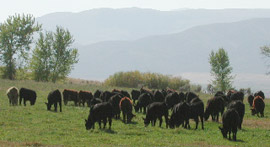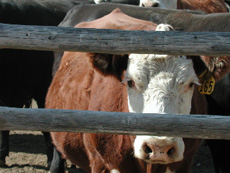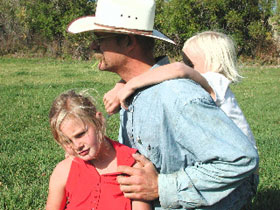Grazing in the Grass
Air Date: Week of January 30, 2004
A small number of ranchers are rejecting the feedlot system and raising their cows on grass. Producer Guy Hand follows one cattleman as he tries to make a go of ranching the old fashioned way, selling direct to a new group of consumers.
Transcript
CURWOOD: It’s Living on Earth. I’m Steve Curwood.
The recent discovery of mad cow disease in Washington State has consumers nationwide worrying about the safety of American beef. The U.S. Department of Agriculture says there's little real risk.
But critics argue that the mad cow scare is just one of numerous problems that arise from an industry that forces farm animals to live increasingly unnatural and unhealthful lives. Some cattlemen agree. Producer Guy Hand visits an Idaho rancher who has abandoned the feedlot and factory-style beef production for the open range.
[LOTS OF MOOING, WHISTLING SOUNDS, GATES OPENING]
ELZINGA: Come on guys, get down there, come on guys.
[SOUND OF CATTLE CLATTERING THROUGH GATE]
HAND: On the Idaho-Montana border, where Lewis and Clark once walked, rancher Glenn Elzinga is weaning his calves.
ELZINGA: Sometimes I wonder if they know, you know, it's this time of year, and they just get that sinking feeling that this is the day, this is the day we must part ways.
HAND: Cows bellow in protest as Elzinga shuts a gate separating mothers from calves for the first time. Cowpoke-lean, his Stetson cocked over a bushy, Wild Bill mustache, Elzinga is all but apologetic as he ushers a few more calves through the gate to new pasture.
ELZINGA: Sometimes we call it Glenn and Caryl's Counseling Center for Wayward Cows.
[MOOING]
HAND: If Elzinga and his wife Caryl were typical ranchers, their soft treatment would be short-lived. They'd send these calves to faraway feedlots where they'd eat an unfamiliar diet of corn and antibiotics, fattened up quickly and efficiently for slaughter. Instead, Elzinga's calves will spend their lives on the pastures where many of them were born.
[SWISHING SOUNDS OF WALKING THROUGH GRASS]
ELZINGA: Really, I'm a grass farmer, because this grass is the foundation of my entire operation.
[GRASS SWISHING]
HAND: Elzinga and two of his five young daughters walk through green pastures. He used to send cattle to the feedlots, but was discouraged by the bleak economics of modern beef production. And he just didn't like the industrialization of something as ancient, as simple, as cowboys, cattle and grass.
|
|
HAND: Writer Michael Pollan agrees. In a scathing critique of the beef industry he wrote for the Sunday New York Times, he lamented the broken connection between cattle and grass. POLLAN: There's a wonderful co-evolutionary relationship between cattle and grass. These are animals who have evolved to be able to digest grass, which is a marvelous trick that we don't have. We cannot digest grass at all. HAND: Pollan calls it a solar-powered food supply. POLLAN: The sunlight feeds the grass, and the grass feeds the ruminants, and along we come and we eat the ruminants. So it's an indirect way for us to get our food energy from the sun. HAND: He says it's an ecologically elegant system, but one beef producers began to abandon in the 1950's. POLLAN: The logic of economics or industry are very different than the logic of biology. If you want to fatten a steer on grass, it can take you two to three years. If you get him off of grass at six months, you can put him on corn – at that point a very hot ration of corn, and some other things -- then you can bring them to market by the time they're 14 months. That's an astonishing thing. HAND: To speed up biology you need a controlled environment. That's where large, centralized feedlots come in. Cattle are fed not grass, but a fattening diet of grain, animal protein and other agricultural byproducts. For the consumer that means more beef at less cost. Still, Pollan says, the feedlot comes at a steep price. POLLAN: The modern feedlot is an astonishing place. I mean it is like a medieval city in that you have this vast, motley population drawn from all over the place, living in very close quarters, with no sanitation. And the result of that kind of environment has always been disease. And disease is a constant threat on the feed lot. Diseases can spread like wildfire, and therefore you've got to use a lot of drugs and antibiotics to keep it under control. HAND: While Pollan looks at the feedlot and sees sick cattle wallowing in their own feces, Gary Weber, animal scientist with the National Cattlemen’s Beef Association, sees something entirely different. WEBER: It's not uncommon on a cool day in the summer in the morning to see cattle kicking up their heels, their tails up in the air, and hooves kicking around having fun with each other in those feedlot settings. And they have fresh food; water available at all times. They've got their buddies with them. It seems like a very pleasant place to be, looking in it from the outside. HAND: Weber says the feedlot isn't the product of cold economics, but came from the extra care pioneers gave the steer they raised for their own families. WEBER: They'd feed grain to that steer and fatten him up, as it were, and they learned that that beef was tastier, more tender, more heavily marbled for their own family's uses. And the word started to spread around and that lead to opportunities for people to raise these animals in more of a commercial way. And the reason being is that consumers' really like the taste, the juiciness, of grain-fed beef. HAND: But writer Michael Pollan finds the feedlot diet a good deal less appetizing. POLLAN: There's not just corn in there. We feed cattle on feedlots a lot of horrible things. We feed them brewery waste. We basically look at cows as repositories for all sorts of junk. And to think that what we feed animals, we're not feeding ourselves is really to kid ourselves. You often hear you are what you eat, but we are also what we eat eats, if you can follow that (laughing). HAND: Mad cow disease travels up the food chain when cattle eat feed containing the brains and spinal tissue of other diseased cows and we, in turn, eat them. Feeding cattle to cattle was banned in 1997, but critics say enforcement is lax. In contrast, organically grown and grass-fed cattle avoid the mad cow risk simply because they are not fed processed animal byproducts. [SOUNDS OF KIDS LAUGHING] HAND: But rancher Glenn Elzinga has other reasons for growing grass-fed beef.
HAND: Do you like it here? MELANIE: Yeah, because there's a lot to do. HAND: Do you like living here? ABIGAIL: Yes, because it's pretty. HAND: Do you like the winter? ABIGAIL: Yes. HAND: Why do you like the winter? ABIGAIL: Because you can slide down hills. HAND: Seven-year-old Abigail smiles a big, slightly mischievous smile, then yanks a handful of grass and tosses it at her sister Melanie. [KIDS LAUGHING AND PULLING GRASS] ELZINGA: Hey, don’t waste the grass guys! You're wasting this grass, cut it out! HAND: But life for the Elzinga family isn't all pastoral bliss. Every cattleman in America confronts the fact that 80 to 90 percent of the beef processing business is controlled by four large packing companies. Those companies have tremendous influence over cattle prices and production methods. So, small ranchers, with profits falling and little bargaining power to wield, are finding it harder and harder to stay in business – feedlot or not. ELZINGA: [Big sigh] I, you know, I believe that independently-operated small farms or small ranches are going to be a thing of the past over the next ten years. I think the only way that I'm going to maintain profitability at a small scale, say 100 to 150 pair of cows, is by trying to find my own market and eliminating the many steps between my production and the consumer. [SAWING SOUNDS OF FIDDLE MUSIC PLAYING IN MARKET, CHATTER OF SHOPPING CROWD] HAND: Here, at the Boise farmer's market, Elzinga looks like he took a wrong turn at the corral. Frozen steak in hand, surrounded not by pasture but office buildings. [CHINKING SOUNDS OF POTS CLANGING, FIDDLE SAWS AWAY] ELZINGA: Want to try some? Absolutely free. No obligation. [FIDDLE OVER AND UNDER] HAND: He had little luck finding customers among his rural neighbors back home, so every summer weekend he drives five hours through Idaho mountains to sell his beef to city folk. ELZINGA: It's a long drive. Yesterday my car died in Fairfield on the way down here and I had to get out and push for a while. HAND: But at least he's found people who appreciate the fruits of his labor. WOMAN (IN MARKET): Wow. That is flavor! ELZINGA: I haven't had one person at this market come back and say they didn't like my beef. And that's a really positive thing, that kind of keeps you going, that kind of puts a little gas on the fire, you know? HAND: Elzinga finds the farmer's market refreshing for another reason. ELZINGA: When you're selling cattle on the commercial market, it's a very negative sort of deal. Because you've got a buyer; he's picking out through your cattle, and he's saying there's something wrong with this one, this one’s got a bad eye, this one’s got a bad foot... you know, they're coming up with excuses not to buy your product. Here, people come back because they like your product. And it makes you feel good. It's a positive thing instead of a negative thing. And I like to build a relationship, I like calling people on a first name, and I like it that they know me. And there's just a lot more meaning to that than shipping my cattle on a truck to a Nebraska feed lot to a guy I've never met in my life, you know? ELZINGA (IN MARKET): What have you tried before? WOMAN: I think I tried the London broil before and it was very, very, very delicious. ELZINGA: Oh, good deal, that's great! [CLINK OF DISHES AS TABLE IS SET, KIDS VOICES] HAND: Elzinga's wife and business partner Caryl also likes the personal contact of the farmer's market but that close connection doesn't pay the bills. Their meat is comparable in price to premium corn fed beef but it can cost several dollars a pound more than supermarket beef. Caryl explains as she fixes dinner. CARYL: You can't sell it at the commodity price. We simply can't compete with the way cattle are raised en mass in feedlots on cheap feed. Just can't do it. HAND: Grass fed cattle are more costly to raise because it takes longer to bring them to slaughter weight. It's also harder to keep the quality of the meat consistent during the winter months when cattle are eating hay rather than fresh grass. CARYL: I don't know if there's a big enough clientele out there who are interested in what we do to actually make a big enough market to make this a viable income for us. [SOUNDS OF RUNNING WATER FROM KITCHEN SINK] HAND: Caryl stares out the kitchen window for a long moment. CARYL: About six months ago we said, you know, either we're going to do this and go at it whole hog and do the whole effort that it’s going to take to market this. Or, we're going to have to rethink everything we're doing -- and maybe quit what we're doing altogether and do something different. I don't think we'd leave the ranch. The kids have already said “Do we have to leave and move to town?” DAUGHTER: I found some candy! CARYL: You found some candy? Where? DAUGHTER: Behind my chair.  Glenn’s grass-fed herd. Glenn’s grass-fed herd.(Photo: ©Guy Hand) |
HAND: Raising five young daughters doesn't give Caryl and Glenn much time to dwell on the future. The kids are hungry now. So they herd them to the dinner table and set out piles of homegrown vegetables and a juicy grass-fed roast.
DAUGHTER: The corn’s ours, the tomatoes are ours, the cucumbers are ours, and the cauliflower is ours. And I love the corn! HAND: There is a small but growing group of ranchers nationwide trying to make a living away from the feedlot, and the problems that arise from industrial agriculture. Critics have long called grass-fed and organic cattlemen naive, but the mad cow scare has quieted much of that criticism. As consumers search for safer beef, ranchers like the Elzinga’s see a chance to preserve not only a fading kind of agriculture, but themselves. For Living on Earth, I'm Guy Hand ELZINGA: Okay, let’s go, let’s pray. Dear Lord, thanks a lot for this food and I pray that you please bless us. FAMILY: [SINGING] Evening has come. The corn is cooked. Thanks be to God, who gives us bread. Praise God for bread. ELZINGA: Okay, dig in! Links
|

 Grass-fed cow.
Grass-fed cow. Mellanie, Glenn, Abigail
Mellanie, Glenn, Abigail





